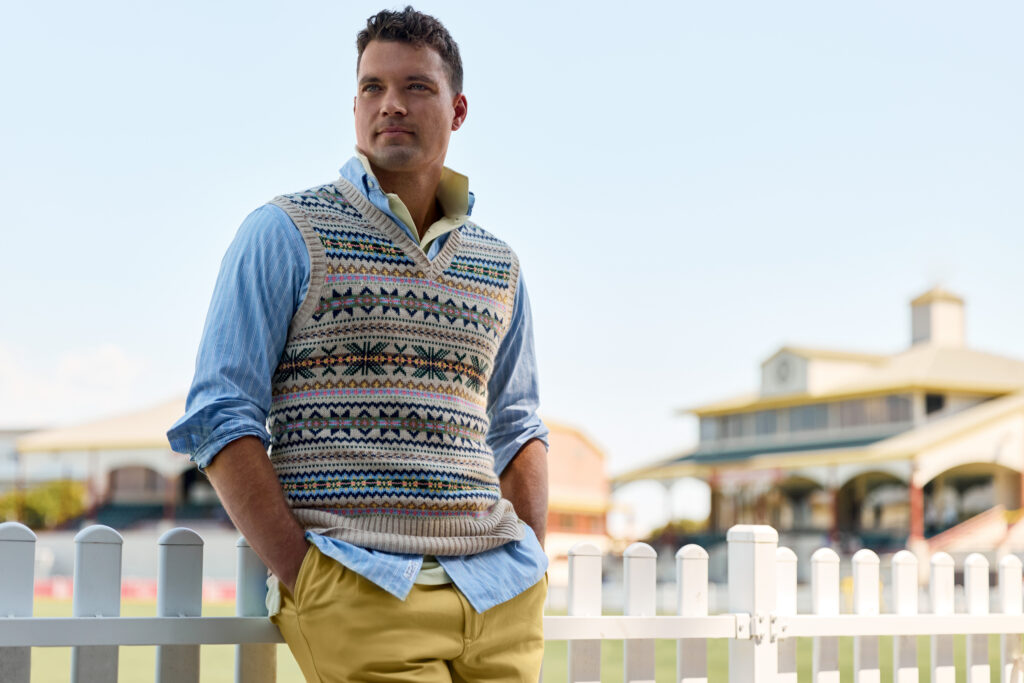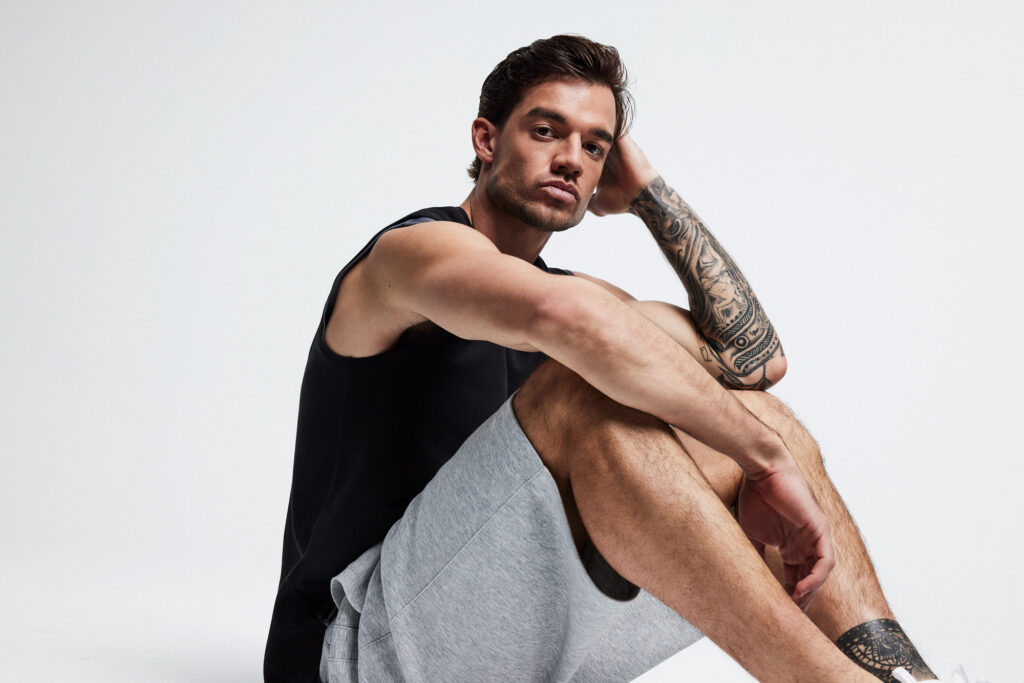FOR A LONG MOMENT, we all felt the kind of heart-in-mouth tension that, as Australian rugby fans, we had almost forgotten how to feel. With the Wallabies trailing England by two points deep into extra time at Twickenham in late 2024, the men in green and gold needed a miracle. Then came the break. Len Ikitau created some space with a monster fend, then sent a flick pass to Max Jorgensen on the left wing. There was nothing but green grass in front of him. The then-20-year-old hit his stride and dove over the try line to give the Wallabies their first win over England, in England, since 2015. A moment of hope for a nation that had been starved of it.
“It’s a bit of a blur now,” Jorgensen, who is a Defender ambassador, recalls on the set of his cover shoot with Men’s Health. “But it was just pure joy. The main thing I remember is all the boys jumping on top of me afterwards.”
And despite the gravity of the situation, Jorgensen didn’t feel any pressure in the moment. “At the end of the day, it’s a rugby field. It’s a big patch of green grass with a couple of white lines on it and some posts,” he says. “I imagine I’m in my backyard playing some footy with my brother and my cousins. Obviously, the other guys are a bit bigger than my brother, but that’s what I like to bring it back to. You can’t let the outside influences get to you, you just have to focus on what’s in front of you and what you have to do.”
It was that game, won by Jorgensen and the Wallabies under such extraordinary circumstances, where the team announced itself as a threat to international rugby’s elite nations once more. In the time since, they have had several inspiring performances, including coming very close to a series win over the British & Irish Lions, a drubbing of the Springboks at Ellis Park, and multiple spells against the insuperable All Blacks where they have looked like the better team.
For the first time in a decade, Australia is feeling the spark again. The sense that maybe the Wallabies could be world-beaters once more. And at the centre of that resurgence is a kid who grew up idolising the gold jersey, whose dad once wore it too, and who now carries the weight of a sport’s revival on his shoulders. At just 21 years of age, that’s a lot to take in.
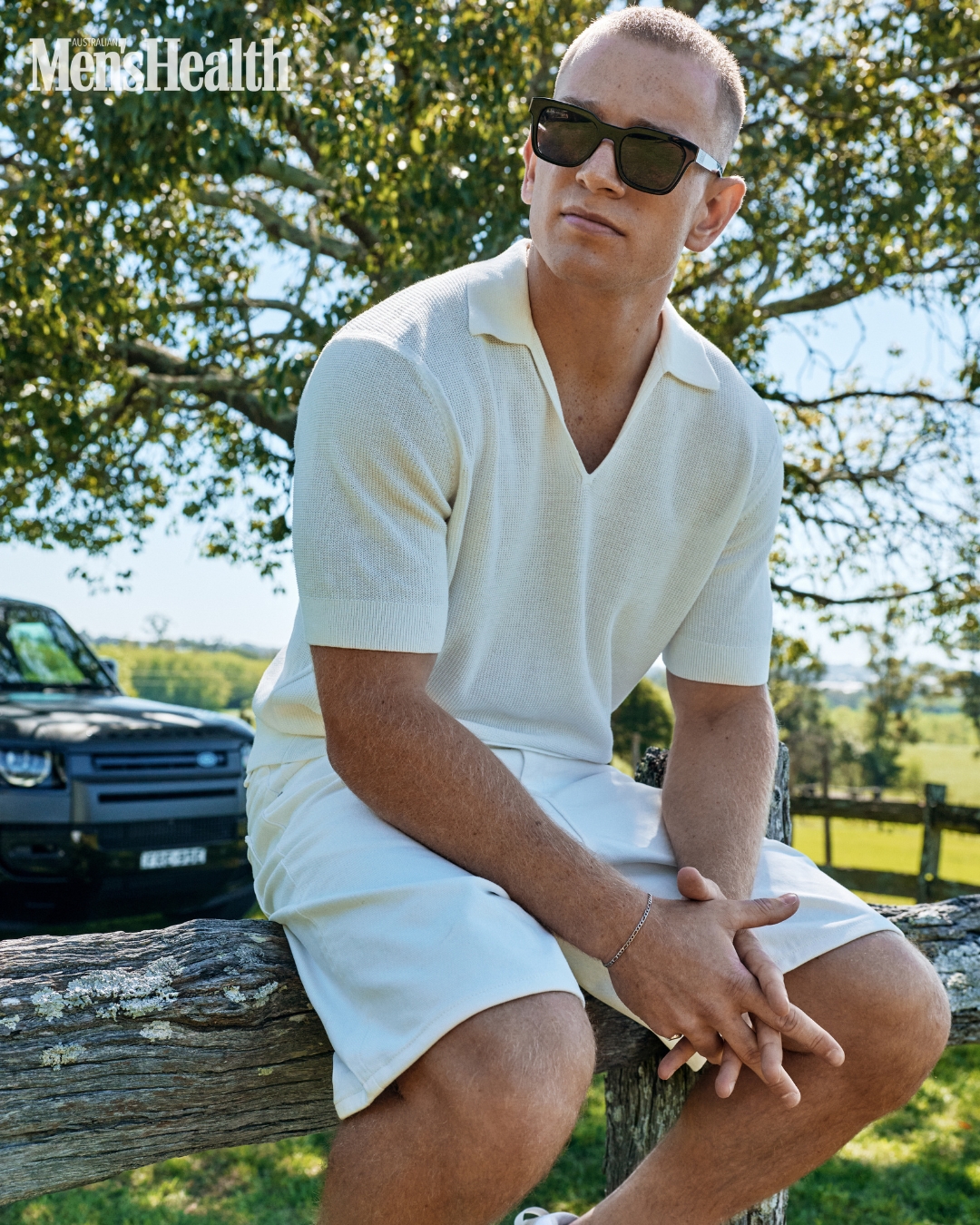
Jorgensen’s cover shoot takes place on a sun-drenched morning at Belgenny Farm in Camden, an hour’s drive from Sydney’s CBD. The setting is disarmingly simple. Paddocks stretching into the distance, the faint sound of magpies warbling. The air is fresh – not like what you get in the city – and a flock of sheep is grazing nearby when Jorgensen rolls up the dirt driveway in a Defender. As Major Partner of the Wallabies, Defender provides players with their own cars.
“We get them on a loan deal,” Jorgensen says with a grin, evidently pleased with the arrangement. “They’re lovely to drive, so smooth. Now that I’ve driven that, I wouldn’t really want another car.”
Dressed in a loose-fitting T-shirt and baggy jeans, Jorgensen moves around Belgenny’s rustic sprawl with a friendly face for our crew, but it’s clear he’s still getting used to all this. There’s a scar hewn into his visage, on his right eyebrow. Such blemishes come part and parcel with playing rugby for a living, but it wasn’t there when I first met Jorgensen a month earlier, so it begets questioning.
“My good mate [fellow Wallabies winger] Harry Potter kicked me in the face in training,” he laughs, touching it lightly. “I had to get eight stitches. It won’t seem to go away just yet.” Our grooming artist is doing his best to disguise the mark, though I think it lends Jorgensen an air of toughness that belies his otherwise boyish looks. And given his profession, it likely won’t be his last. In any case, it’s a fitting reminder that behind the confidence is a young man who has been through more than most at his age.
Before that try against England, Jorgensen’s career was defined by frustration. In just his first two seasons of professional rugby, he suffered a string of injuries that would test anyone’s resolve and threatened to derail his career before it started. In early 2023, Jorgensen joined the Wallabies training squad for the first time and looked set for a fast-tracked debut, only to tear his MCL. After making a full recovery, Eddie Jones stacked his faith in Jorgensen by selecting him in his 2023 World Cup squad, but he broke his leg just before the tournament began. In 2024, a hamstring strain delayed his debut even further. Injuries are often a matter of luck, and Jorgensen, you’d have to say, certainly hasn’t had much of it.
“It was a really tough time,” he admits. “I remember my first couple of injuries, I had the mindset of Why me? Why is this happening? Then I sort of shifted that to thinking It is what it is. It’s part of the sport. Once I looked at it that way, I think I really grew as a player and as a person.”
There’s no trace of self-pity in Jorgensen’s tone. When he finally got his Wallabies call-up, he says it “felt like redemption.” Scoring the winning try against the country of his birth – Jorgensen was born in Sheffield, South Yorkshire – cemented his place in the first team. But while Jorgensen is eligible to represent England, he assures us he has no plans to switch allegiances. “I’ve got an English passport, which helps,” he says, “but I’ve always thought of myself as an Aussie.” That’s music to the ears of a Wallabies die-hard, because in many ways, the team needs Jorgensen far more than he needs them.

Hope has been in short supply for a generation of Australian rugby fans. The last decade has been a carousel of coaching changes, disappointing campaigns and a slow drift away from the national consciousness. In the space of ten years, the Wallabies went from World Cup finalists to not making it out of the pool stage for the first time in history. The Bledisloe Cup hasn’t been held by Australia since before Jorgensen was born, crowds have dwindled, young athletes are turning to league in growing numbers, and for some time, the Wallabies have felt like a relic of a more glorious past.
In 2024, however, something shifted. Under the guidance of coach Joe Schmidt, the Wallabies found form again, beginning with that famous victory over England. “I think it’s a big testament to what Joe [Schmidt] has been able to do as coach over the past year or two,” Jorgensen says. “He’s completely changed the way we play, including our mindset. I think we can definitely be the best team in the world.
The Wallabies have risen from a historically low world ranking of 10th to, at the time of writing, 7th. It remains a far-cry from the days when the team was perennially inside the top five, but there is hope they will continue to rise, especially if you listen to Jorgensen, whose ascension has run parallel with the Wallabies transformation.
“We’ve still got a few areas and things that we’re working on and stuff we need to get out of our game,” he says, pragmatically. “But I think over the next couple of years we’ll be in contention for being the best team in the world.”
“Hopefully we can get the Bledisloe back, too,” he continues. “It’s hard in a two-game series if you’re not the holder because you’ve got to win both, and that means winning over in New Zealand. But I reckon that’s on the horizon. Hopefully in the next couple of years, we have that.”
Jorgensen speaks without bravado, but he is quietly confident. Though he’s quick to acknowledge there’s still work to do, or “a few areas that we’re working on,” as he puts it. But for the first time in a long time, the Wallabies are talking about when, not if, they’ll reclaim rugby’s biggest prizes.
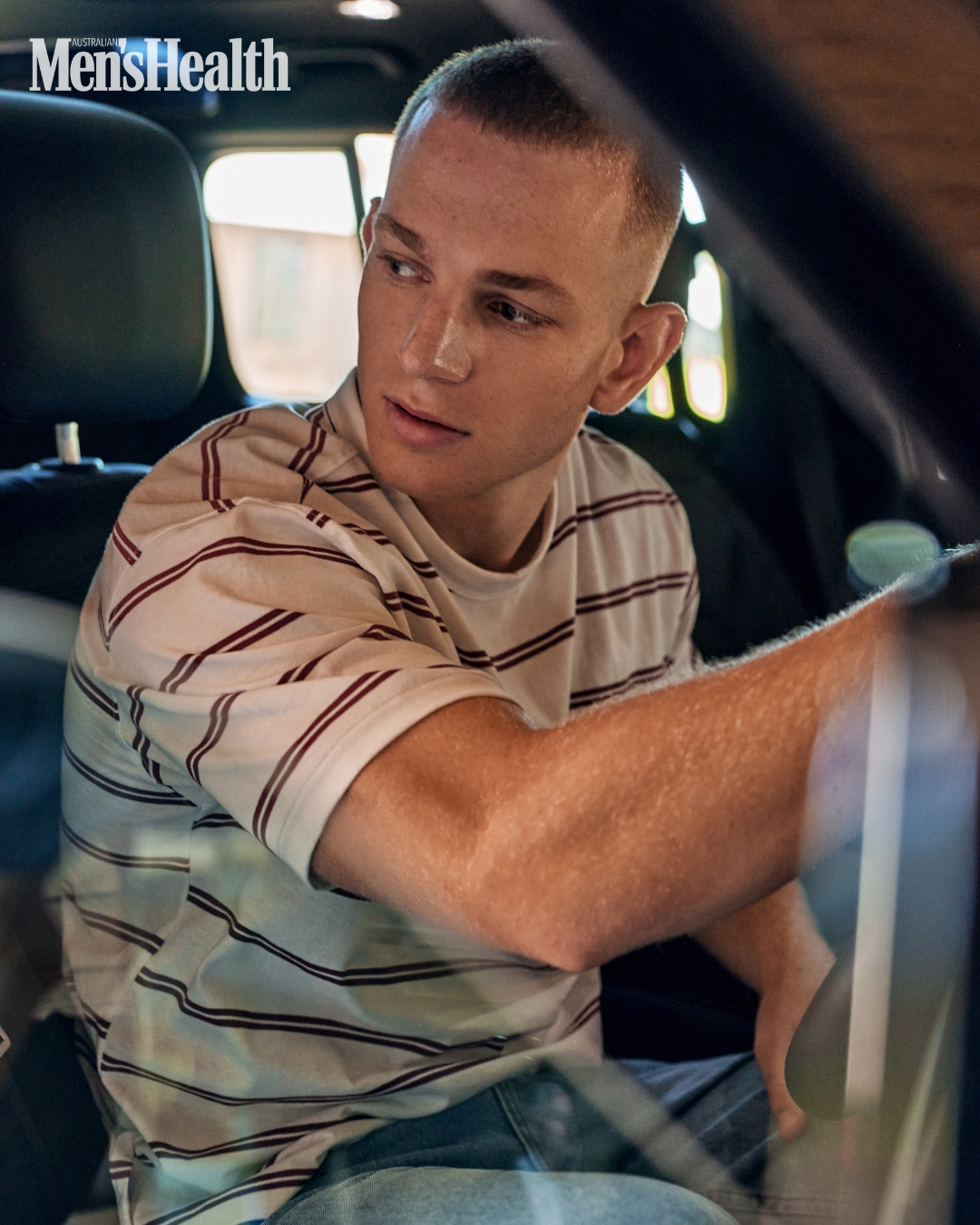
As the clock winds down on our shoot with Jorgensen, the time comes for the all-important cover shot. To this point, every shot has required Jorgensen to be fully clothed. But, as is famously the case, Men’s Health’s covers are typically shot shirtless.
As we make our way to the spot selected for the cover shot – right by Jorgensen’s Defender, which has been positioned underneath a mighty oak tree – I suggest that he might want to do a few push-ups to get a quick pump going. Jorgensen is initially dismissive and laughs it off, but as the crew gathers and the expectant eyeballs on him increase, he says “you might be right actually” and sneaks away for a few quick reps.
When he returns, it’s difficult to see what he was worried about. Jorgensen possesses a rig that Michelangelo might sculpt, with broad shoulders, a chiselled six-pack and substantial biceps that were previously hidden under his baggy shirt. Once he’s in front of the camera, he’s shaken off all the nerves and is back to his confident self.
Jorgensen’s composure was shaped by his family. His father, Peter Jorgensen, was a code-jumper who played two tests for the Wallabies and more than 100 games in the NRL. Rugby is, quite literally, stitched into to the younger Jorgensen’s DNA. “I always expected that Max would end up playing footy,” Peter told me when we met a month prior to Max’s cover shoot. “Him and his brother were always rough and tumble kids and got into it pretty early. It didn’t take me too long to work out that he had a gift.”
Back at Belgenny, Max says that he’s “Obviously played rugby my whole life,” but it wasn’t until he was 16 or 17 that he thought “I’m actually good enough to give it a crack.” Growing up in Balmain, Jorgensen attended famed rugby nursery St Joseph’s College, putting him on a path to the pros. “Joey’s was massive for me,” he says. “I learned so much there, not just from coaches, but from the people around me. I played some high-level rugby there, which also gave me a nice pathway into the Waratahs system.”
Now, as Jorgensen navigates the spotlight of professional sport, he believes his strong upbringing remains his greatest asset. “I’ve been really lucky with the way I was brought up,” he says. “I’ve got such a lovely family, I couldn’t have asked for better parents. I’m really grateful for that. All the credit goes to my mum and dad, hopefully they’ve shaped me into a good guy.” One who, you’d think, might be equipped to handle both the riches and responsibilities his gifts look set to bestow.
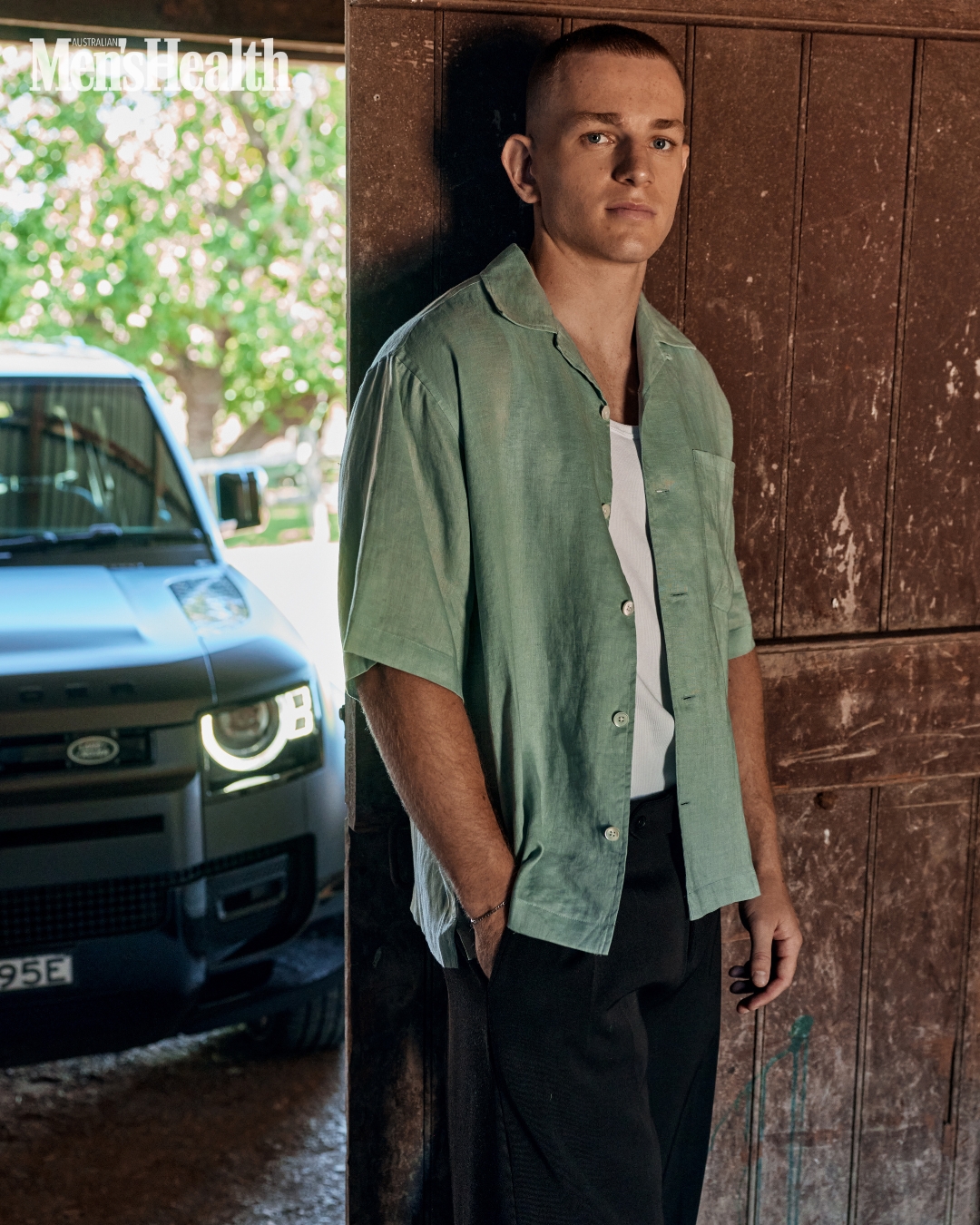
Despite his youth, Jorgensen’s maturity stands out. When asked about his long-term ambitions, he’s reflective rather than boastful. “I’m still young and still learning so much from the older boys and the coaches,” he says. “Consistency is one thing I’m working on, but really I want to just keep improving all aspects of my game.”
He doesn’t flinch at the suggestion that he could one day be one of the world’s best, and feels that building a stronger bond with the Wallabies playing group will result in improvements on the playing field. “The Wallabies’ season is almost longer than the Super Rugby season, so you spend so much time with them,” he says. “By the end you’re a bit sick of them. You want to go home for a bit. You want to stop seeing Harry Potter’s face.”
And while union is, strictly, Jorgensen’s focus right now, I’ll remind you that he is still only 21 and his horizons are broad. Like his dad, Jorgensen has flirted with the idea of switching codes. “I grew up playing league and I’ve always loved it,” he says. “It’s definitely not off the table. It’s always been a dream of mine to play league, so we’ll see what happens.”
It’s a comment that could send shockwaves through rugby circles — but it’s also a reminder that Jorgensen is still working out who he wants to be. For now, his sights are firmly set on union. And that’s welcome news.

At a time when the Wallabies – and rugby union in Australia – are desperate for heroes, Max Jorgensen is in an almost messianic position. Nevertheless, he refuses to be rattled by the noise.
Jorgensen is just trying to be better one game at a time. He’s the kind of athlete who impresses through how he plays, not what he says. It’s a mindset that will serve him well heading into the next World Cup, one that will be played on home soil. “World Cups on home soil don’t come around often,” he says. “It’s really special. Every game is essentially a home game. Hopefully we can win it. That’s the plan, anyway.”
There’s no self-mythologising with Jorgensen. He knows that much of the weight of the Wallabies future rests on his shoulders, but he won’t boast about it. He’ll continue to quietly improve, and maybe that’s exactly what Australian rugby needs right now – less noise, more action.
Back on that night in 2024, when he scored the winner, the crowd erupted and his teammates mobbed him on the sideline, Jorgensen didn’t think about what it would do for his legacy. He thought about playing footy in his backyard as a kid, the sound of his mates cheering and the rush of pure joy. At its best, that’s what sport is all about: those fleeting seconds when everything clicks. When a 21-year-old kid from Balmain, playing in the jersey his dad once wore, can remind a country what it feels like to believe. And that Australian rugby’s next golden era might have already begun.

In opening image, Max wears Hayden shapes shirt, Venroy pants, his own shoes.
Words: Cayle Reid
Photography: Steven Chee
Head of Brand: Ben Jhoty
Creative Director: Grant Pearce
Production director: Rebecca Moore
Fashion assistant: Kailee Waller
Videographer: Jasper Karolewski
Grooming: Kristyan Low
Design: Evan Lawrence








